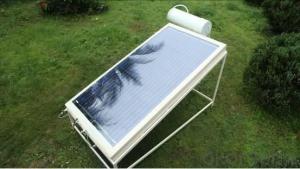China Polycrystalline Solar Cells with High Efficiency and Stable Performance
- Loading Port:
- Shanghai
- Payment Terms:
- TT or LC
- Min Order Qty:
- 5000 pc
- Supply Capability:
- 9000000 pc/month
OKorder Service Pledge
OKorder Financial Service
You Might Also Like
Polycrystalline Silicon Solar Cells:
Solar cells is made by solar wafer, it has three categories of solar cell right now, monocrystalline polycrystalline and thin film,These cells are entirely based around the concept of ap-n junction, which is the critical part of solar module, it is the part that can convert the light energy into electricity, the thickness is from 180um to 200um, with even busbars to conduct electricity, textured cell can decrease diffuse reflection; they are often electrically connected and encapsulated as a module. Photovoltaic modules often have a sheet of glass on the front (sun up) side, allowing light to pass while protecting semiconductor wafers from abrasion and impact due to wind-driven debris, rain, hail, etc. Solar cells are also usually connected in series in modules, creating an additive voltage. Connecting cells in parallel will yield a higher current;With high quality and stable quality. Our Cells can greatly improve the performance of Solar Modules.
Polycrystalline Silicon Solar Cells Advantage:
• High efficiency and stable performance in photovoltaic conversion.
• Advanced diffusion technique ensuring the homogeneity of energy conversion efficiency of the cell.
• Advanced PECVD film forming, providing a dark blue silicon nitride anti-reflection film of homogenous color and attractive appearance.
• High quality metal paste for back surface and electrode, ensuring good conductivity, high pulling strength and ease of soldering.
• High precision patterning using screen printing, ensuring accurate busbar location for ease with automatic soldering a laser cutting.
Specification:
Mechanical data and design |
Format - 156 mm × 156 mm ± 0.5 mm |
Thickness- - 200 μm ± 20 μm |
Front (-) - 1.4 mm bus bars (silver),blue anti-reflection coating (silicon nitride) |
Back (+) - 2 mm wide soldering pads (silver) back surface field (aluminium) |
Temperature Coefficient of Cells |
Voc. Temp .coef.%/K -0.364%/K |
Isc . Temp .coef.%/K +0.077%/K |
Pm. Temp. coef.%/K -0.368%/K |
Electrical Characteristic |
Efficiency (%) Pmpp (W) Umpp (V) Impp (A) Voc (V) Isc (A) |
18.00% 4.380 0.538 8.141 0.634 8.740 |
17.90% 4.356 0.538 8.097 0.634 8.725 |
17.80% 4.331 0.537 8.065 0.633 8.710 |
17.70% 4.307 0.536 8.035 0.632 8.695 |
17.60% 4.283 0.535 8.006 0.631 8.680 |
17.50% 4.258 0.534 7.974 0.630 8.665 |
17.40% 4.234 0.533 7.944 0.629 8.650 |
17.30% 4.210 0.532 7.914 0.628 8.635 |
17.20% 4.185 0.531 7.88 -- 0.627 -- 8.620 |
17.10% 4.161 0.530 7.851 0.626 8.605 |
17.00% 4.137 0.529 7.820 0.625 8.590 |
Intensity Dependence |
Intensity [W/m2] Isc× [mA] Voc× [mV] Pmpp |
1000 1.00 1.000 1.00 |
900 0.90 1.000 0.90 |
800 0.80 0.99 0.80 |
500 0.50 0.96 0.49 |
300 0.30 0.93 0.29 |
200 0.20 0.92 0.19 |
IV Curve

Solar Panel Images:
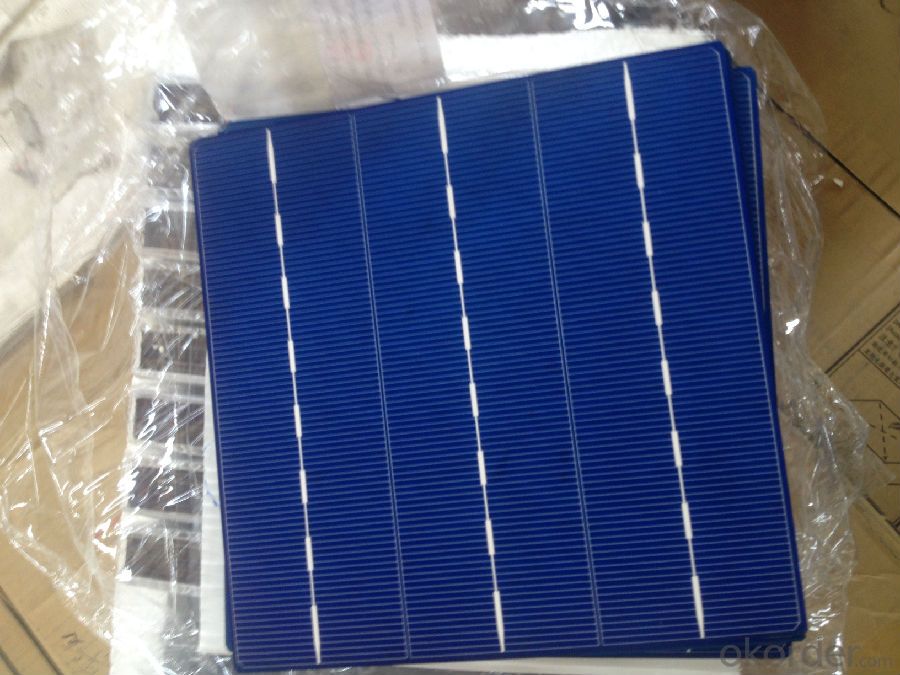
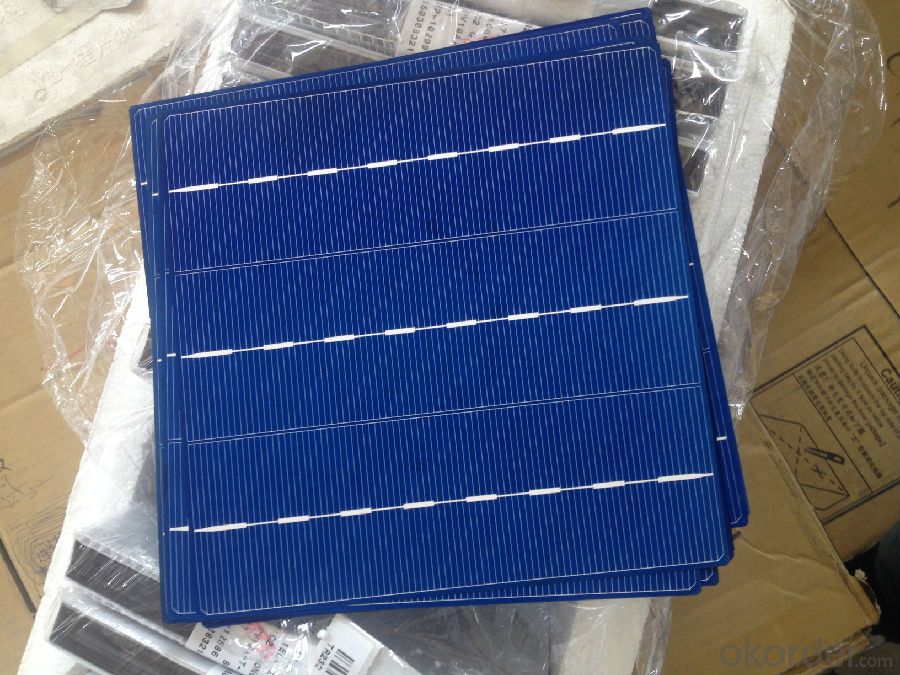
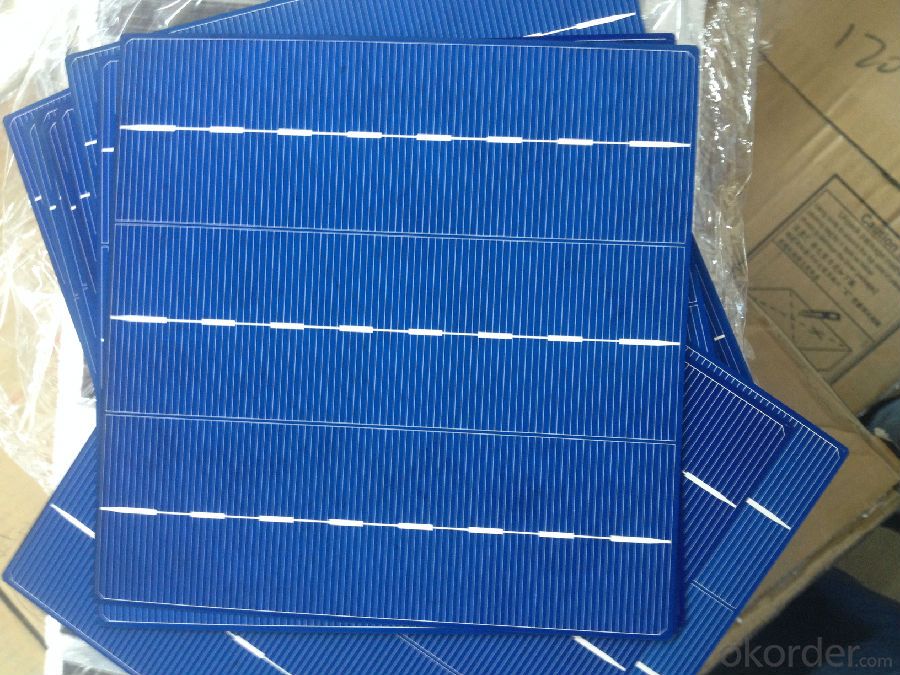
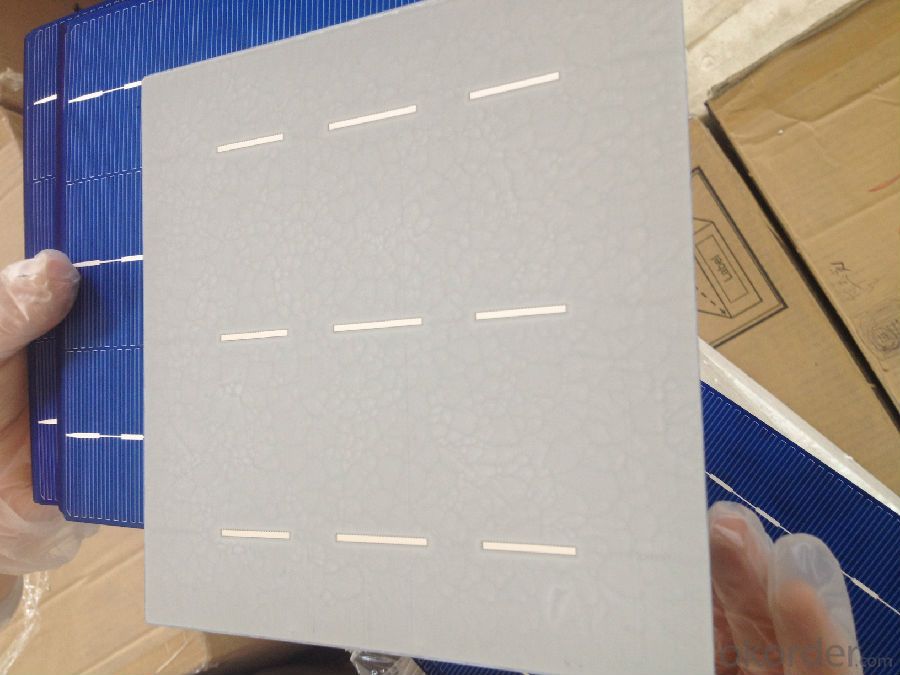
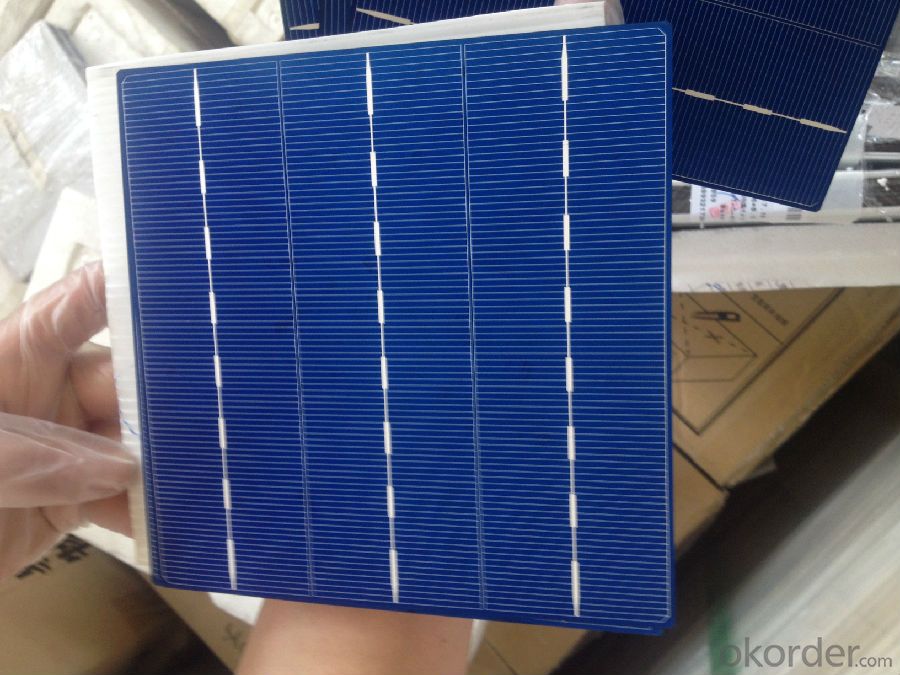
FAQ
We have organized several common questions for our clients,may help you sincerely:
①What price for each watt?
It depends on the efficiency of the solar cell, quantity, delivery date and payment terms.
②How long can we receive the product after purchase?
In the purchase of product within three working days, We will arrange the factory delivery as soon as possible. The pecific time of receiving is related to the state and position of customers.Commonly 7 to 10 working days can be served.
③Can you provide the peripheral products of the solar panels, such as the battery, controller, and inverter? If so, can you tell me how do they match each other?
Yes, we can, we have two companies for solar region, one is CNBM International, the other is CNBM engineering Co.
We can provide you not only the solar module but also the off grid solar system, we can also provide you service with on grid plant.
④What is your warranty of solar cell?
Our product can promise lower than 0.3% open box crack, we support claim after opening the box if it has crackm color difference or sth, the buyer should give pictures immediately, we can not accept the claim after the solar cell has assembled to solar panel.
• Timeliness of delivery
• ⑤How do you pack your products?
We have rich experience on how to pack the solar cell to make sure the safety on shipment, we could use wooden box or pallet as buyer's preference.
⑥ Can you do OEM for us?
Yes, we can.
New Achievement of Chinese solar cell research
Professor Xiong Yujie group from China Science and Technology University have designed a photoelectric conversion can be carried out and has a flexible solar cell mechanics in the near infrared region based on the widely used semiconductor silicon material, the use of hot electron injection method of metallic nanostructures. Most solar cells are for visible light absorption, accounting for 52% of the sunlight near-infrared light has not been used efficiently. To solve this problem, based on previous research group Xiong Yujie semiconductor - metal interface, creatively having a near-infrared light absorption properties of silver nano-chip with integrated silicon nanowires to build two different photovoltaic devices, the near infrared region photoelectric conversion characteristics are improved. In the near-infrared light, the silver nano-chip generated hot electrons can be injected directly into the silicon semiconductor, the band of the photoelectric conversion.
In addition, conventional solar cells must be processed into hard plate-like objects, which limit daily use. Lightweight and flexible devices, and can be folded, crimped, pasted on a surface, such as automotive glass, roof, clothes. Xiong Yujie group of commercial silicon nano process combined with silver nano-sheet near-infrared light absorption properties, to create a near-infrared solar cell having mechanical flexibility.
Experts said the work by nano-manufacturing and nano-synthesis two kinds of nano effective combination of technologies to achieve a broad spectrum of the light-absorbing composite structures design and the development of a simple and effective near-infrared flexible solar cell manufacturing method is expected to for the development of smart thermostat and wearable solar cells solar cells.
- Q:How do solar cells affect the environment?
- Solar cells have a positive impact on the environment. They produce clean, renewable energy by converting sunlight into electricity, reducing the reliance on fossil fuels. Solar cells emit no greenhouse gases or air pollutants during operation, helping to combat climate change and improve air quality. Additionally, they have a minimal impact on water resources and land use compared to other energy sources.
- Q:How do solar cells perform in dusty environments?
- Solar cells can experience a decrease in performance in dusty environments as dust particles can block sunlight from reaching the surface of the cells, reducing their efficiency. Regular cleaning and maintenance are necessary to ensure optimal performance in such conditions.
- Q:Can solar cells be used to power remote monitoring systems?
- Yes, solar cells can be used to power remote monitoring systems. Solar cells convert sunlight into electrical energy, which can be stored in batteries or directly used to power monitoring devices. This makes solar cells a reliable and sustainable solution for remote monitoring systems that require continuous power in areas where grid electricity may not be available or practical.
- Q:Can solar cells be used in hotels?
- Yes, solar cells can be used in hotels to harness solar energy and generate electricity for various applications such as lighting, heating, and powering hotel facilities. This not only reduces dependence on traditional energy sources but also helps promote sustainability and reduce carbon footprint in the hospitality industry.
- Q:Can solar cells be used in agriculture?
- Yes, solar cells can be used in agriculture. Solar panels can generate electricity that can power various agricultural applications such as irrigation systems, livestock water heaters, and electric fencing. Additionally, solar energy can be harnessed to power greenhouse operations, improving crop yields and reducing reliance on traditional energy sources.
- Q:Can solar cells be used in water heating systems?
- Yes, solar cells can be used in water heating systems. They can be used to capture sunlight and convert it into electricity, which can then be used to heat water through various mechanisms such as heating elements or heat exchangers. This allows for a more sustainable and cost-effective way of heating water, reducing reliance on traditional energy sources.
- Q:How do solar cells handle power quality issues?
- Solar cells do not directly handle power quality issues. However, inverters are used in solar power systems to convert the direct current (DC) generated by solar cells into alternating current (AC) that can be used in homes and businesses. These inverters often have built-in features to address power quality issues such as voltage fluctuations, harmonic distortions, and frequency variations. Additionally, grid-tied solar systems can rely on the electrical grid itself to handle power quality issues, as any excess power generated by solar cells can be fed back into the grid, ensuring a stable and reliable power supply.
- Q:What is the role of solar cells in powering off-grid cabins?
- Solar cells play a crucial role in powering off-grid cabins by harnessing sunlight and converting it into electricity. These cells, also known as photovoltaic cells, generate renewable energy that can be stored in batteries for later use. This sustainable power source eliminates the need for traditional electricity grids, allowing off-grid cabins to be completely self-sufficient.
- Q:How are solar cells installed?
- Solar cells are typically installed on rooftops or in open spaces where they can receive maximum sunlight. The installation process involves mounting the solar panels onto a structure using brackets or frames. The panels are then connected to an inverter, which converts the direct current (DC) generated by the cells into alternating current (AC) for use in homes or businesses. Finally, the system is connected to the electrical grid or battery storage, allowing for the utilization of solar energy.
- Q:How do solar cells perform in different climates?
- Solar cells can perform well in various climates, although their efficiency may vary. In regions with abundant sunlight and higher temperatures, solar cells can generate more electricity. However, extreme heat can slightly reduce their efficiency. In colder climates, solar cells can still produce electricity, although their output may be lower during winter months due to reduced sunlight. Overall, solar cells can function effectively in different climates, but the specific performance may depend on the local weather conditions.
1. Manufacturer Overview |
|
|---|---|
| Location | |
| Year Established | |
| Annual Output Value | |
| Main Markets | |
| Company Certifications | |
2. Manufacturer Certificates |
|
|---|---|
| a) Certification Name | |
| Range | |
| Reference | |
| Validity Period | |
3. Manufacturer Capability |
|
|---|---|
| a)Trade Capacity | |
| Nearest Port | |
| Export Percentage | |
| No.of Employees in Trade Department | |
| Language Spoken: | |
| b)Factory Information | |
| Factory Size: | |
| No. of Production Lines | |
| Contract Manufacturing | |
| Product Price Range | |
Send your message to us
China Polycrystalline Solar Cells with High Efficiency and Stable Performance
- Loading Port:
- Shanghai
- Payment Terms:
- TT or LC
- Min Order Qty:
- 5000 pc
- Supply Capability:
- 9000000 pc/month
OKorder Service Pledge
OKorder Financial Service
Similar products
New products
Hot products
Hot Searches
Related keywords











